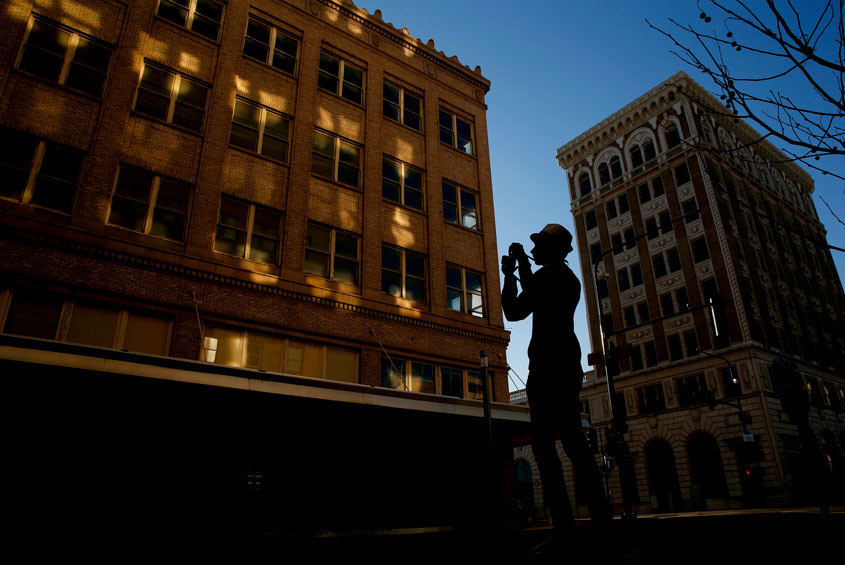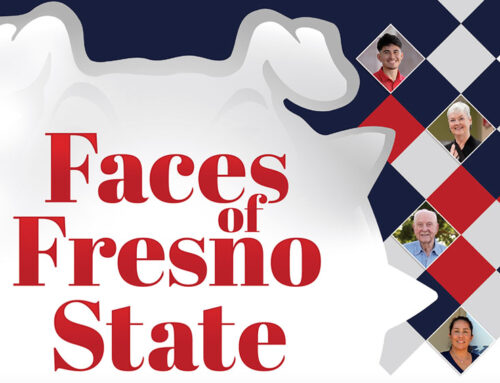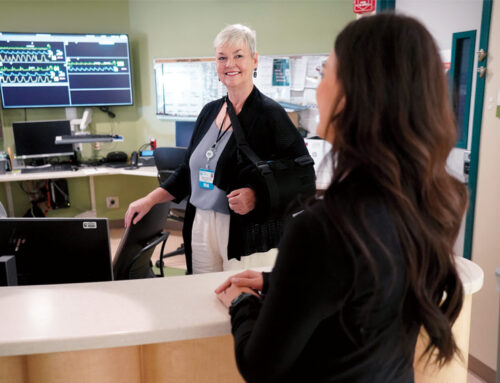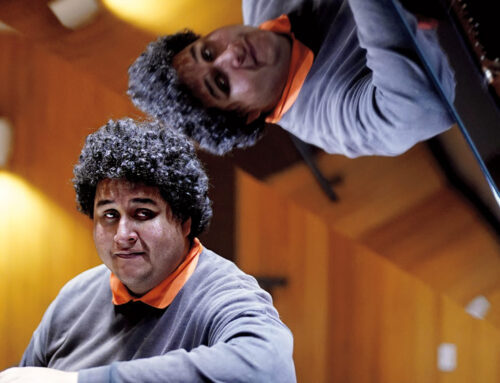Urban Evolution
Alumni Behind the Downtown Turnaround
By Eddie Hughes | Photos by Cary Edmondson
The following is based on a true story. It’s about the fall — and rise — of a downtown located in California’s fifth largest city. The story begins with an alarming deterioration of the historic urban center of the city that was booming in population while shriveling at its core. Right before our eyes, the area our parents and grandparents once saw thriving morphed into an afterthought as struggling businesses became shuttered storefronts turned deserted buildings. The people flocked north, east and anywhere but downtown.
This is a story about Fresno. And in true comeback fashion, the region hopes it will have a happy ending — but there is a long way to go. The good news is several characters, including some who are about to be introduced, are working toward what will one day become the final chapter to this story. For now, this is a story with a yet-to-be-determined conclusion. But it’s a story that needs to be told, and retold, to help spark the movement that will once again make Fresnans proud of their downtown.
THE LEADERS
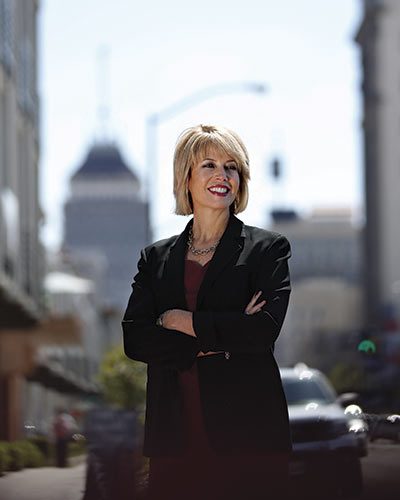 It’s 7 o’clock in the evening on a Tuesday in downtown Fresno. A new class on the history of Fresno architecture is wrapping up at Fresno State’s Downtown Center inside the Bitwise South Stadium building on Van Ness Avenue. When the class started about an hour earlier, a few dozen people were passing by outside. Even fewer people will be around when the class ends.
It’s 7 o’clock in the evening on a Tuesday in downtown Fresno. A new class on the history of Fresno architecture is wrapping up at Fresno State’s Downtown Center inside the Bitwise South Stadium building on Van Ness Avenue. When the class started about an hour earlier, a few dozen people were passing by outside. Even fewer people will be around when the class ends.
Therein lies the biggest obstacle for downtown revitalization — how to (greatly) increase foot traffic.
The daytime hours Monday through Friday aren’t so much the issue. But how does downtown attract people to stay after hours and come back on the weekends to eat, drink and explore? From an entertainment perspective, it’s about being creative and becoming a destination by offering something different and authentic.
The years-long process of opening the historic Fulton Mall to vehicle traffic this past October was the first step. More than 15,000 people showed up for the official opening with pop-up businesses, a dozen musicians performing and eateries buzzing with patrons.
Chat with the movers and shakers in downtown revitalization, and many of them will bring up the same names when talking about the city’s visionaries — including Ashley Swearengin, a former Fresno mayor. Swearengin is quick to point out the downtown movement was afoot well before her time at City Hall, but there’s no question her administration pushed forward some key projects.
“The Central Valley needs a major downtown marketplace. It’s the DNA or thumbprint of our community,” says Swearengin, a 1994 and 1997 Fresno State alumna now serving as president and CEO of the Central Valley Community Foundation. “It’s our unique skyline and historic buildings. It’s one of the few places in the Valley that are uniquely identifiable.”
With Fulton Street now open to traffic, downtown businesses can become more identifiable.
“Now that we have good visibility for our businesses and additional on-street parking so people can get to them, we can help businesses be more successful,” says Craig Scharton, a Fresno State alumnus and former urban entrepreneurship instructor who is interim CEO of the Downtown Fresno Partnership. “With dining, entertainment and culture, we can go from a daytime downtown to a nighttime fun and entertainment district.”
That’s the vision. And with 1.7 million people living within a 45-minute drive of downtown, there’s no reason it shouldn’t be a cultural hub for the region.
Scharton says he has been a student of cities and their downtowns for more than 30 years. He’s tracked 175 cities that removed pedestrian malls like Fulton, and 90 percent of those cities revitalized their downtowns within four years.
Scharton points to an example just 45 minutes down Highway 99 in Visalia. “In the Valley, Visalia has done a better job than anybody else with nearly the same demographics Fresno has,” Scharton says. “When you have a downtown with fun stuff to do, people show up. It’s no different here.”
THE DEVELOPERS
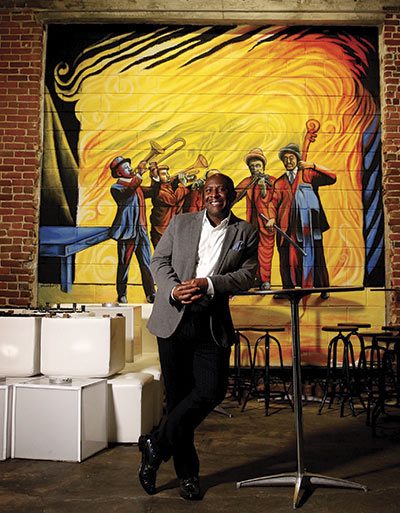 Events and entertainment are one way to increase downtown foot traffic — and certainly part of the equation — but there’s also a more reliable way. “Housing, housing, housing,” says Terance Frazier, the CEO of TFS Investments, which prides itself on bringing economic opportunities to distressed neighborhoods. “You’ve got to have people living downtown so, at nighttime, if they don’t want to drive somewhere, they just walk downstairs. We need to get away from the notion of making people drive downtown. Housing is the key.”
Events and entertainment are one way to increase downtown foot traffic — and certainly part of the equation — but there’s also a more reliable way. “Housing, housing, housing,” says Terance Frazier, the CEO of TFS Investments, which prides itself on bringing economic opportunities to distressed neighborhoods. “You’ve got to have people living downtown so, at nighttime, if they don’t want to drive somewhere, they just walk downstairs. We need to get away from the notion of making people drive downtown. Housing is the key.”
Frazier, a former Fresno State baseball standout who helped the Bulldogs make the 1988 College World Series and was drafted by the Oakland Athletics in 1992, has been involved in various developments downtown and has high hopes for a block of properties he owns on the east side of H Street when and if high-speed rail arrives. Frazier envisions the properties, south of Chukchansi Park, becoming a block of housing, restaurants, pubs and more.
More immediately, Frazier and business partner Mehmet Noyan are preparing to break ground this summer on a new, three-story mixed-use building called The Park on the corner of Fulton and Inyo streets that will include a 54-unit apartment complex with 7,000 square feet of retail space on the bottom floor, complete with a rooftop bar. Half of the units will overlook Chukchansi Park, home of the Triple-A Fresno Grizzlies baseball team. Frazier hopes to have people moving in by 2020.
Head a couple miles northwest up Fulton Street and it’s easy to see the potential for creating attractive urban living communities in downtown. Housing and retail mixed-use spaces dot both sides of Fulton and Broadway for several blocks, including the Iron Bird Lofts and Broadway Lofts developed by 1998 Fresno State alumnus Reza Assemi. He says his lofts are 100 percent full and there’s a waiting list of up to 10 people to get in.
“It’s interesting because I don’t think people understand how much downtown has actually changed,” Assemi says. “I would never have dreamed in 18 years that downtown would have changed as fast as it has.”
Assemi’s first project downtown was The Pearl building in 2000. He was inspired by studying downtown Portland, Oregon. For perspective, he points out that Portland started revitalizing its downtown in the 1970s, and, in 2000, Portland revitalization was already 25 years in the works. “It’s going to take time,” he says. “That’s really important to remember. Nothing happens in six months.”
THE CULTURE
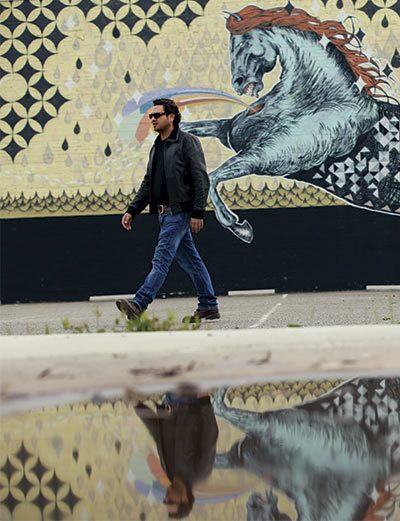 Assemi is a developer, yes, but he’s an artist at heart — and it shows in his projects, which feature everything from murals outside and inside his buildings to gargoyle sculptures perched atop the Iron Bird Lofts to metal heart-shaped designs detailed in staircases to represent the heart of Fresno. “The arts make me feel good,” Assemi says. “I love seeing murals put up and helping the arts any way I can. We have an amazing creative community here.”
Assemi is a developer, yes, but he’s an artist at heart — and it shows in his projects, which feature everything from murals outside and inside his buildings to gargoyle sculptures perched atop the Iron Bird Lofts to metal heart-shaped designs detailed in staircases to represent the heart of Fresno. “The arts make me feel good,” Assemi says. “I love seeing murals put up and helping the arts any way I can. We have an amazing creative community here.”
His motivation is to preserve historic buildings and create spaces for artists to work and to share with the public. ArtHop, an event hosted by the Fresno Arts Council the first and third Thursday of every month, now has more than 40 participating locations in downtown Fresno.
“As a culture, we’re getting younger people who see more and more value in older things that are special,” Assemi says. “It’s not like the previous generation in the ’70s that wanted to knock everything down. Keeping the nostalgia is cool.”
That historic vibe and the arts, including music and theatre, can make downtown Fresno the cultural center of the Valley. And that’s something everyone involved would like to see. Scharton hopes to see the city’s historic theatres put into more active use. “It’s difficult for individual businesses to generate the foot traffic they need upfront, but if you have concerts and movies and plays at your larger venues, that spills out into restaurants, bars and coffee houses.”
The same holds true for sports. When the Fresno Grizzlies’ stadium opened in 2002, it was seen as a catalyst for downtown revitalization. The Grizzlies’ creative promotions like Taco Truck Throwdown have been a hit. Add the new professional soccer franchise Fresno FC, which will also call Chukchansi Park home, and downtown Fresno will have 79 sporting events booked between the two teams.
Derek Franks, president and general manager of the Grizzlies, says that will draw at least 600,000 people downtown this year.
And now with Fulton Street open to traffic, the Kern Plaza outfield entrance to the stadium has all-new pregame potential. Imagine parking near Fulton Street, eating at a restaurant before the game and seeing live music before entering the stadium. “There is a chance that over time, Kern Plaza will become the main entrance,” says Franks, a 2007 Fresno State alumnus. “Connecting the experience at the ballpark to Fulton is very important to us.”
A similar synergy between the stadium and the Brewery District is already in the works. Tioga-Sequoia Brewing Co. sits on the corner of Fulton and Inyo streets just across from the stadium. With its popular craft brews and outdoor beer garden, it has quickly become a destination for large music events like FresYes Fest.
On F Street near Ventura Street, the longest running brewery in Fresno, Full Circle Brewing Co., has brought in several big-name musicians and comedians and hosted roller derby while also partnering with Fresno State’s Downtown Center to offer a unique course for people interested in learning how to brew.
“There’s not a linear path to success downtown,” says Arthur Moye, the CEO of Full Circle. “You have to be nimble, you have to want it bad enough to change on a whim and figure out what your customers want. There’s not a 100-percent proven formula down here so you’ve got to be an entrepreneur.”
THE PEOPLE
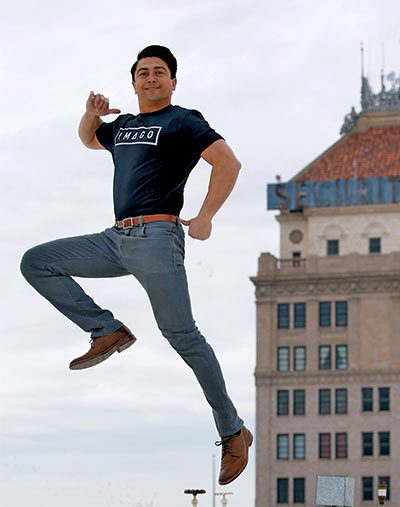 Brew U is a series of courses designed for people interested in commercial or home brewing, and is one of dozens of courses open to the public through Fresno State’s Downtown Center located at Bitwise South Stadium. Other course topics include everything from Fresno architecture and painting to professional development in things like Adobe Photoshop or grant writing.
Brew U is a series of courses designed for people interested in commercial or home brewing, and is one of dozens of courses open to the public through Fresno State’s Downtown Center located at Bitwise South Stadium. Other course topics include everything from Fresno architecture and painting to professional development in things like Adobe Photoshop or grant writing.
Dr. Scott Moore, the University’s dean of Continuing and Global Education, says the Downtown Center is an opportunity for Fresno State to partner with the community and invest in downtown revitalization. “This is about Fresno State doing right in the community,” Moore says. “It’s not about making money.”
“The Fresno State name brought comfort to people signing leases. We’re just one player, but at the same time, we have a responsibility to be that player.”
In 2015, Fresno State also opened its Graduate Art Studios at the M Street Arts Complex downtown, where students work with faculty and professional artists.
Sarah Moffat, who chairs the Downtown Fresno Foundation, envisions even more downtown partnerships with the University. Some of the foundation’s recent projects include planning of public spaces and storefront renovations on Fulton Street — things she can see students being a part of. She says she hopes to one day see a satellite campus where city and regional planning students (page 24) are attending class and doing hands-on projects downtown.
“Fresno State is already an active leader in downtown Fresno,” she says. “To have our region’s largest higher ed institution invest in revitalization by not only words, but actions, is so very important. Fresno State brings an air of credibility along with a student population that predominately has not spent a great deal of time downtown.”
Swearengin and Scharton agree. “It’s consistent with what we’ve seen in other successful cities,” Swearengin says. “Anchor institutions will either help or hurt, will either contribute to the decline or contribute to bringing downtown back. The University is absolutely doing the right thing.”
But perhaps Fresno State’s greatest contribution to downtown revitalization is the people who have been educated at the University and are proving
to be instrumental in the movement. People like Edgar Blunt, who co-founded IMAGO with Jason Shoulet, and in just over four years has grown the company to 12 employees and relocated from Bitwise South Stadium to the eighth floor of the T.W. Patterson Building on Fulton Street and Tulare Avenue.
IMAGO partners with school districts and other organizations throughout the U.S. to deliver learning experiences that prepare people for the workforce and facilitate their career options. Unlike retail businesses in the area, IMAGO doesn’t rely on foot traffic to succeed, but the company has embraced the downtown revitalization movement and is committed to depositing its entrepreneurial spirit in the area.
Blunt, a 1998 Fresno State graduate, tirelessly points out that in a company like his, it takes a whole team of entrepreneurs to make a difference. And in a downtown like Fresno’s, it will take dozens of teams full of entrepreneurial spirit to spark growth.
“There’s a lot of things people should be excited about and proud of when it comes to downtown,” Blunt says. “This is our community, and the more stories like this that people see and hear, the more we can start changing the narrative about our city’s self-esteem.”
Downtown is evolving, one project at a time. It’s not a quick fix, and it’s an ever-changing environment, but it’s happening. This story introduced several characters who are but a small representation of the hundreds of entrepreneurs, visionaries and investors who are reshaping downtown. But, ultimately, the final chapter of this story will be written by you and your friends and your families.
When downtown Fresno earns your consistent business, provides your entertainment and even your job or your home — that’s when this comeback story will be complete.
This is not the end — and perhaps there is no end. There are just new beginnings.
Eddie Hughes is senior editor for Fresno State Magazine.
DID YOU KNOW?
Fresno State’s Downtown Center, located at Bitwise South Stadium, offers a wide range of courses open to the public related to professional development and personal growth. For the full list of upcoming courses at Fresno State’s Downtown Center, including Craft Beer 101, visit www.fresnostatedowntown.com

